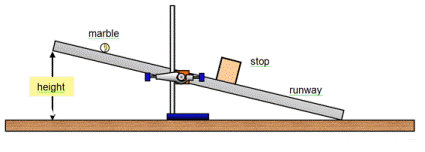Arrange the desk in a way such that the direction of launch will be clear for at least 4 meters.
Vertical marble launcher physics.
The launcher can launch at angles from 0 horizontal to 90 degrees vertical.
Durable apparatus to study velocity acceleration and projectile motion.
Extra problems 1 a car dnves offa wharf at 15 m s if the wharf is 25 m above water calculate.
First set the angle to 50.
Place the launcher on a flat surface and then role tape measure out directly beside the marble launcher.
Sturdy hardwood construction is built to last.
You can use a bubble level to align the.
Shoot the marble twice and record both distances traveled.
A marble with a speed of 2 0 m s rolls off the edge of a table 1 8 m high a how long does it take it to hit the floor.
A the time of flight assume down is positive.
The angle can be changed by untightening the large knob on the rear of the launcher arm of the marble launcher and rotating the launcher arm to the appropriate angle then retightening the knob.
The solid heavy base provides an easy to use and reliable setup.
For this experiment you will use angles from 0 to.
Put the timer in interval mode and connect the photogate to input a.
C setting up the marble launcher c 1 1.
B the horizontal distance.
Place the cpo launcher near the edge of a student desk.
Velocity of the marble can range from 3 m s to 9 m s.
Easy to read protractor allows for precise measurements and calculations.
Launch steel balls at angles between 0 and 70 degrees and over distances up to 2 5 m.
First set the launcher so it aims at an angle of 0 degrees.
Use the vernier projectile launcher to investigate important concepts in two dimensional kinematics.
Attach one photogate to the marble launcher so that the marble breaks the light beam as it comes out of the barrel.
B how far from the table will it hit the floor.

